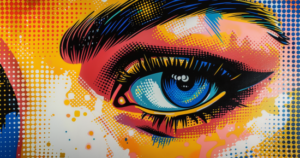If you are familiar with the world of art, you might have encountered the term “line art” and questioned its significance. Line art is an illustration technique that employs clear, straight, or curved lines in a single color, usually black, to create an image without incorporating shadows or color areas. This approach highlights the form and depth of depiction, enabling the artist to convey a sense of dimension without depending on shading or different color hues.
Line Art
With its roots in historical artwork, line art has become a popular and versatile form of artistic expression. Line art can be two-dimensional, three-dimensional, abstract, or imply depth and dimension using various line weights and angles. This drawing technique can be seen in famous pieces by Gustave Doré, and it is often utilized in everything from cartoons and caricatures to technical illustrations and glyphs.
To find your style, you can experiment with different line weights, textures, and subject matters. Don’t forget that, like any other form of artistic expression, practice is key to mastering line art. So, grab your preferred drawing tools and let your creativity flow.
Defining Line Art
When it comes to art, there are many techniques and styles to explore. One such technique is line art. Line art is drawing without the use of shadows or blocks of color. Instead, artists use distinct straight or curved lines, typically in one color (usually black), and forgo the shades or hues that create the illusion of dimension or depth. The concept behind line art is quite simple: It’s a drawing that relies on lines to represent an existing object or thing. The style emphasizes form and often varies in line width, ranging from constant widths in technical illustrations to freely varying widths in brushwork or engraving.
Techniques and Styles

Materials and Tools
When it comes to exploring line art, you have a variety of materials and tools at your disposal. Traditionally, artists have used pens, pencils, or ink brushes to create detailed linework on paper or canvas. The choice of tool can significantly impact the final result. Pens offer solid and precise lines, while brushes may produce more varied and expressive strokes. Don’t forget that you can experiment with different tip sizes, ink colors, and types of paper to find the combination that suits your style.
In digital line art, you’ll discover a new world of possibilities. Working with a graphic tablet or tablet computer and a digital drawing program like Adobe Illustrator or Procreate, you can create endless line weight, color, and texture variations. With the added advantage of layers and the ability to quickly correct mistakes, digital tools can make the creation process smoother and more enjoyable.
The decision between digital and traditional line art often comes down to personal preference, available resources, and your specific artistic goals. Both mediums have pros and cons, so it’s important to consider what works best for your style and needs.
Here’s a brief comparison to help guide you:
| Digital Line Art | Traditional Line Art | |
|---|---|---|
| Pros | – Undo and edit easily | – Tactile experience |
| – Infinite colors and tools | – Unique, physical artwork | |
| – Layers for complex scenes | – No need for technology | |
| Cons | – Need for digital devices | – Permanent mistakes |
| – May lack a personal touch | – Limited in editing options | |
| – Learning curve | – Limited tools and colors |
Ultimately, you may find yourself drawn to one medium over the other, or perhaps you’ll embrace both for different situations. Whichever way you go, remember that the key to mastering line art is consistent practice and refinement of your techniques. You’ll enjoy exploring the styles and methods available in line art and watching your skills and artistic voice evolve.
Applications of Line Art

Fine Art
It relies on various techniques to emphasize form and create drawings, ranging from constant-width lines in technical illustrations to freely varying widths in brushwork and engraving. The beauty of line art is its ability to either lean towards realism or take a more abstract approach.
When exploring line art in the fine art realm, you are likely to encounter works across various mediums, including:
- Pencil drawings
- Pen and ink sketches
- Charcoal renderings
- Digital illustrations
- Printmaking
As you delve into the world of line art, you’ll discover its versatility and the endless creative possibilities it can offer.
Commercial Use
Line art has many practical applications in the world of commercial design. Its simplicity and clarity make it an ideal choice for different purposes, such as:
- Advertising: Line art illustrations often create eye-catching visuals that convey a brand’s message quickly and effectively.
- Graphic Design: Designers often utilize line art in logos, icons, and typefaces to establish a distinct, memorable brand identity.
- Technical Manuals: Clear, easy-to-understand line drawings are frequently employed in technical manuals and instructional materials to help explain complex processes or mechanical components.
- Comics and Storyboards: Line art is an essential element in comic books and storyboards, as it enables artists to create engaging visual narratives that can be easily adapted to different formats, such as film or animation.
Incorporating line art into your commercial projects can add a unique, elegant touch that effectively communicates your message without overwhelming the viewer.
Creating Your Line Art

Step-by-Step Guide
Line art is a minimalist approach to art that focuses on using lines to create images without shadows, shades, or color blocks. To create your line art, you can follow these simple steps:
- Choose your tools: Artists can use various tools like pens, pencils, brushes, or digital tools to create line art. To decide on the best tool for you, experiment with different materials to find the one that feels most comfortable and produces the desired effect.
- Define your subject: You’ll want to focus on one main subject, like an object or a figure, to draw. Remember, line art aims to simplify the subject by using distinct straight or curved lines.
- Sketch your outline: Begin by lightly sketching an outline of your subject to establish its shape and form. Pay attention to the significant lines and shapes that accurately represent your subject.
- Refine your lines: Once you have your outline, start refining your lines, focusing on the flow and continuity. You can use various line techniques, such as hatching or crosshatching, to enhance your artwork.
- Digitize (optional): If you prefer working digitally, you can scan your physical drawing and edit it using software like Photoshop, Procreate, or other online tools.
Tips and Best Practices
- Practice: Creating impressive line art takes time and, like any other art form, requires practice. So, don’t get discouraged if your initial attempts aren’t perfect.
- Stay consistent: Consistency is crucial in line art since it relies on just lines. Keep your lines‘ thickness, style, and spacing consistent throughout your artwork.
- Experiment with different line techniques: Familiarize yourself with various line techniques like hatching, cross-hatching, and stippling to add texture and depth to your creations.
- Try abstract or stylized subjects: Line art allows for a wide range of creative freedom, so don’t be afraid to experiment with abstract shapes or stylized subjects.
- Embrace your unique style: Line art is a personal expression, and there is no “right way” to create it. Develop your signature style by trying new techniques and tools that resonate with you and your artistic vision.
By following the above steps and keeping these tips in mind, you’ll be well on your way to creating stunning line art that showcases your unique artistic talents.
FAQ – Line Art
What is line art?
Line art is a style of illustration that uses distinct straight or curved lines to create shapes, forms, and patterns without shading or color. It emphasizes the outline and structure of the subject, often resulting in a minimalist and elegant appearance.
What materials can I use to create line art?
You can create line art using various materials like pens, markers, pencils, or digital tools like graphic design software. The choice of material often depends on the desired effect and the medium you work with, whether paper, canvas, or a digital platform.
How can I incorporate line art into my home decor?
You can incorporate line art into your home decor by framing prints or original pieces and hanging them on your walls. Line art can also be used in textiles, such as throw pillows or curtains, and in decorative items like vases or wall decals, adding a modern and stylish touch to your space.






